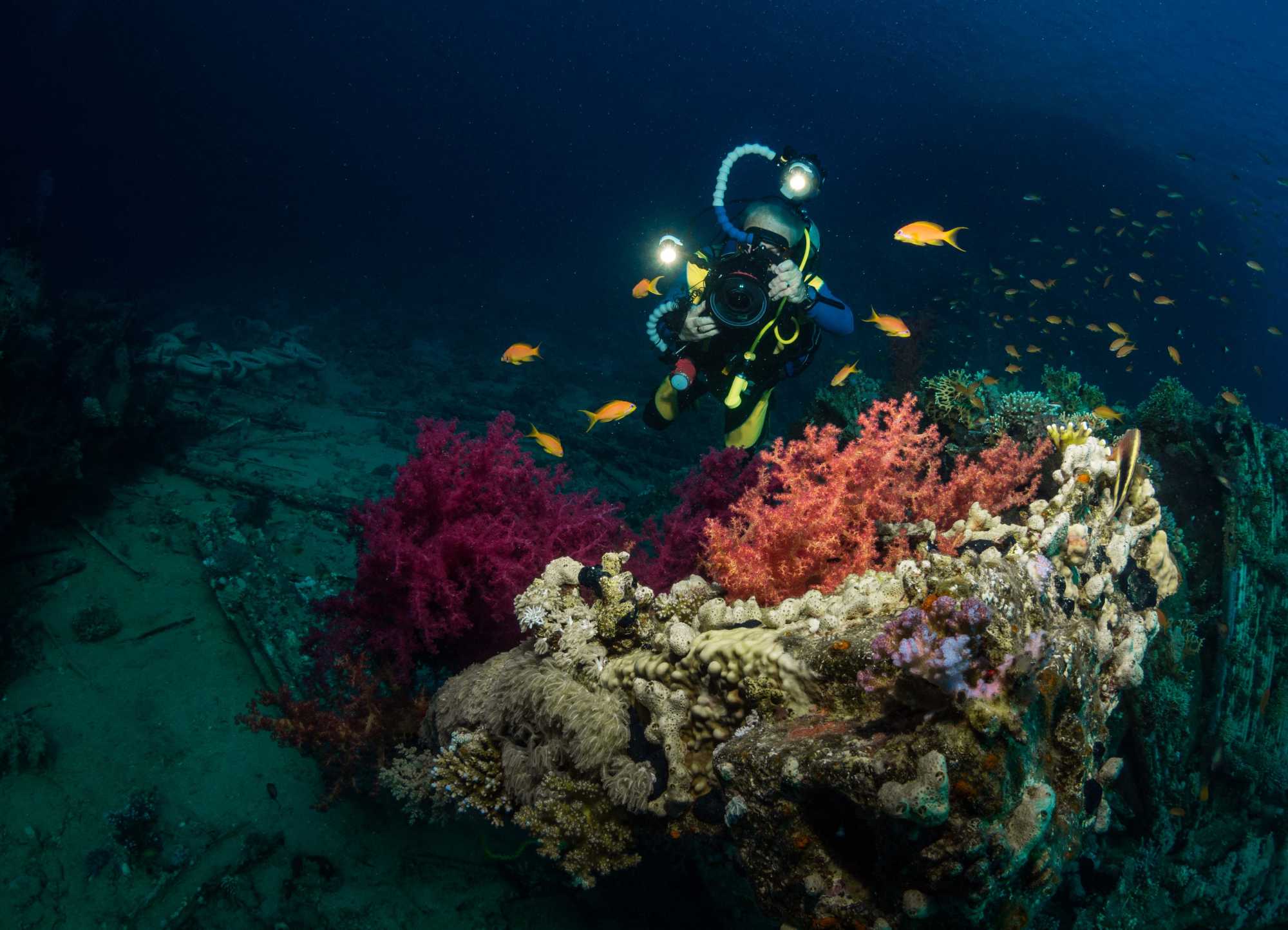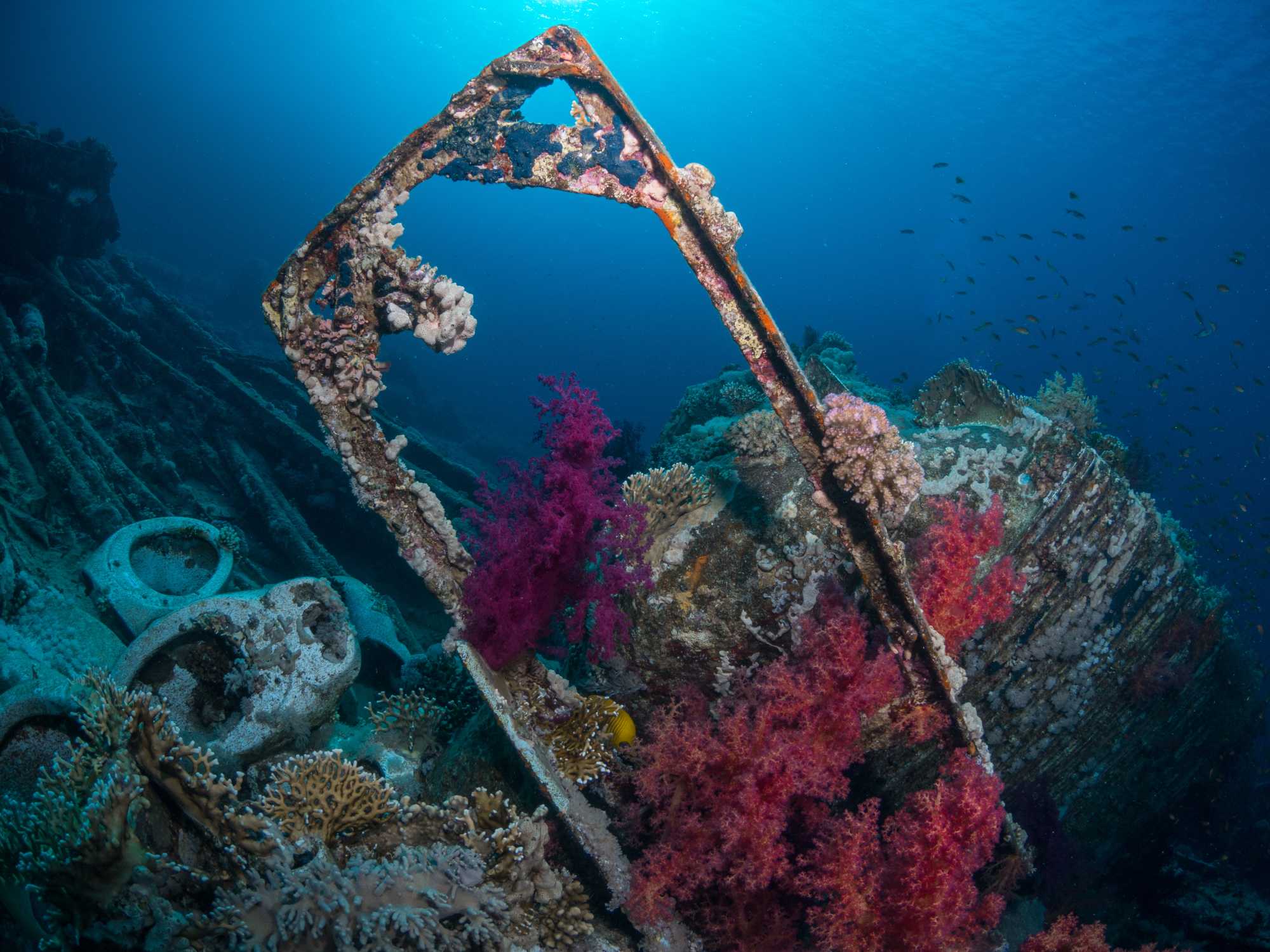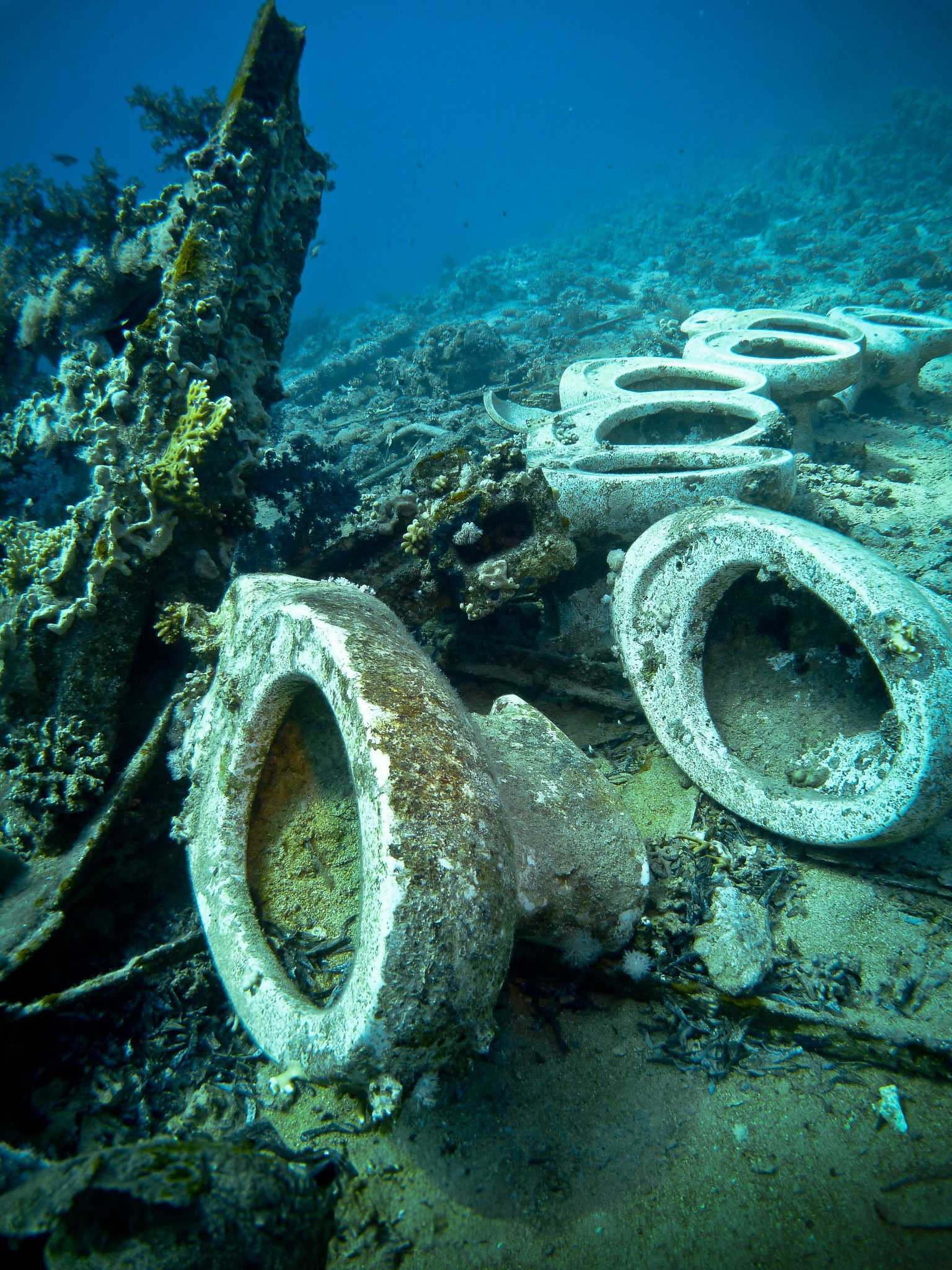Yolanda Wreck Dive Red Sea: The Egyptian Toilet Treasure
- Written:
- By Christian Llewellyn
Some of the links on this page may be affiliate links. If you click on them and make a purchase, we may earn a small commission at no extra cost to you. This helps us continue our work—thank you for your support!
Introduction to the Yolanda wreck
Located in the awe-inspiring waters of the Red Sea’s Ras Mohammed National Park, the Yolanda Wreck Dive offers a unique and intriguing diving experience for enthusiasts around the world. The ship, originally a Cypriot cargo vessel, met its fate in these waters, rendering it an underwater spectacle with a distinctive cargo spread amidst vibrant coral reefs. This dive site, now synonymous with ‘toilet reef’ due to its unusual cargo, not only challenges adventurous divers but also provides abundant photographic opportunities unlike any other.

The Story Behind the Yolanda
The Yolanda began its journey as a motor fishing vessel, constructed in 1964 in Gijón, Spain. It was later converted for use as a cargo transporter by Seabrother Marine Co Ltd, Piraeus. The ship’s eventful journey culminated on 1 April 1980 when it suffered engine failure and ran aground on the reef at Ras Mohammed. Originally resting on its port side in shallow waters, the ship was a popular spot for divers until 1987, when a severe storm dislodged it, causing it to slide into a deep underwater chasm beyond the reach of recreational divers.
The wreck remained a mystery until December 2005 when it was rediscovered by technical divers Leigh Cunningham and Mark Andrews. Found at depths ranging between 145-160 metres, the wreck consists largely of scattered metal debris and structural remnants. Near its original site, currents have distributed an array of bathroom fixtures like toilets and bathtubs across the coral heads, creating an unusual and photogenic underwater landscape. This ‘Yolanda Reef’ section, while not deep, attracts a variety of Red Sea reef species, adding a vibrant natural touch to the man-made spectacle.

The Stats: Depth, Conditions & Accessibility
16m
Minimum Depth
30m
Maximum Depth
Boat Dive
Dive Type
30m
Visibility
Apr – Nov
Season
22°C - 28°C
Water Temp
Where Is The Yolanda?
The Yolanda wreck is located in the Egyptian part of the Red Sea near the southern tip of the Sinai Peninsula. The dive site, near popular diving destinations like Sharm El Sheikh, can be accessed via boat from local marinas and dive centers, which offer day trips to Ras Mohammed National Park where the wreck lies. Several airlines provide flights to Sharm El Sheikh International Airport, which is the nearest air access for international tourists. From the airport, it’s a short travel to local hotels and dive centers that organize the actual dive trips. Dive logistics are well-supported, with options ranging from beginner courses to advanced wreck and technical dives, comprising types of accommodations and services to suit a wide range of budgets and preferences.
My Experience Diving The Yolanda

The Yolanda Wreck Dive in the Red Sea was an unforgettable journey submerged in history and marine beauty. The dive was organized by a reliable local dive company, whose experienced guides were thorough in their briefings and passionate about Ras Mohammed’s underwater treasures. The dive began with a boat entry, the sun just beginning to paint the morning sky, creating an almost surreal backdrop as we geared up.
Descending into the crystal-clear waters, my first glimpse of the Yolanda wreck was awe-inspiring. Scattered across the ocean floor were the famous bathroom fixtures that have whimsically earned this site the nickname ‘toilet reef’. Each piece told a story of its voyage and dramatic sinking in 1980, creating an unusual yet fascinating underwater landscape. The dive conditions were ideal, with mild currents and great visibility, allowing our group to fully immerse in the exploration of this large freighter’s remains.
The dive was not without its challenges, balancing buoyancy and navigation around and through the extensive debris field. Yet, each moment was a learning experience, drawing us closer to the life that once was aboard the SS Yolanda. Exiting the dive, I felt a profound sense of accomplishment and deep respect for the power of nature and the sea’s ability to reclaim what once belonged to the land.
My Experience Photographing the Yolanda
Photographing the Yolanda Wreck in the Red Sea was an extraordinary challenge yet a truly unique opportunity. Nestled at the edge of Yolanda Reef at Ras Mohammed, the wreck hosts an array of scattered bathroom fixtures, which adds an unusual yet fascinating layer to the typical wreck scenery. Armed with my DSLR equipped in an underwater housing, I set out to capture the eerie allure of the submerged cargo amid the rich marine life that has claimed it as home. Adjusting the settings constantly to cope with the varying light and depths was part of the adventure, and each dive session felt like peeling back a new layer of this underwater mystery.

What You’ll See: Wreck Features & Marine Life
The marine life around the Yolanda wreck is vibrant and diverse, offering an excellent opportunity for those interested in Red Sea wreck photography. As you swim through the clear blue waters, you can expect to encounter an array of coral encrusted on the wreckage, teeming with life. Schools of colorful fish dart through the water, while larger species like groupers and barracudas patrol the deeper shadows of the wreck. Visibility is typically good, allowing divers to capture stunning photographs of the wreck and its aquatic surroundings.
Among the surreal sights are the mentioned bathroom fixtures, now part of the coral landscape and home to smaller marine species. Beyond its ecological beauty, the Yolanda wreck offers a bizarre yet captivating slice of maritime history, nestled within one of the most scenic diving spots in the world—the Yolanda Wreck Dive Red Sea.

Recommendations for Diving the Yolanda
1. Ensure you are well-trained in wreck diving before attempting the dive, as this often involves complex navigation and potential hazards.
2. Check local diving conditions including visibility, currents, and weather patterns before the dive to ensure safety.
3. Use a dive guide who knows the specific wreck well, to enhance safety and the overall experience.
4. Prepare and check all dive equipment thoroughly, focusing especially on lights, dive knives, and line markers for wreck penetration.
5. Stick to dive plans and limits strictly, including maximum depths and bottom times, to avoid decompression sickness.
6. Maintain neutral buoyancy to protect the integrity of the wreck and prevent stirring up silt, which can reduce visibility.
7. Be mindful of sharp edges and entanglement hazards due to the wreck’s metal structure and any fishing nets or lines.
8. Use a dive computer to monitor and manage your dive depth and time accurately.
9. Respect the wreck, considering it as a potentially historical artefact and preserve the site by not removing any objects.
10. Be aware of your gas supply and manage air consumption appropriately to ensure a safe return to the surface.
Tips for Photographing the Yolanda
1. Use a wide-angle lens to capture the expanses of the wreck. This is essential for encompassing the vast, scattered remnants of the Yolanda amidst the expansive backdrop of the Red Sea.
2. Adjust your white balance manually to enhance the vivid colors of the coral and marine life against the metal and ceramic remains. The stark contrast can produce visually stunning images.
3. Consider the natural light and plan your dive times around it. Early morning or late afternoon sun can provide the best natural lighting conditions for underwater photography at Yolanda Reef.
4. Bring powerful strobe lights or underwater flash systems. The deep and sometimes murky waters around the SS Yolanda wreck can diminish natural light, making artificial lighting a necessity.
5. Capture the unique elements of the wreck, like the famous bathroom fixtures. These quirky features are not only conversation starters but also serve as intriguing focal points in your compositions.
6. Enhance your buoyancy control. Good buoyancy skills are crucial when maneuvering in and around wrecks to avoid kicking up sediment which can ruin the clarity of your shots.
7. Lastly, always be cautious and respectful of the marine environment. Disturbing the site not only affects the ecological balance but also diminishes the visual beauty that makes Yolanda Reef diving Sharm so special.
Practical Dive Info & Booking a Trip
For those looking to explore the Yolanda Wreck, I recommend booking with local operators such as ‘Aqua Dive Sharm’ or ‘Red Sea Plungers.’ Typical costs for a dive trip to Yolanda Reef range around $100 to $150, depending on the package chosen, which usually includes equipment rental and guide services. It’s crucial for divers to respect the site by not taking any artefacts and avoiding contact with structures to preserve its condition for future explorers. Engaging in respectful and responsible diving practices helps maintain the beauty and integrity of this exceptional dive site.
My Rating & Final Thoughts
Diving the Yolanda Wreck in the Red Sea was an unforgettable experience. This dive site, with its unusual remnants including bathroom fixtures, brings a whole new layer of intrigue to wreck diving. Capturing the unique underwater scenes, made famous by the scattered remains of toilets and baths, was a highlight for Red Sea wreck photography enthusiasts. The blend of vibrant marine life with the historical narrative of the shipwreck made each dive remarkably engaging and photogenic. For anyone fascinated by both natural and artificial underwater environments, the Yolanda Wreck proves to be an exemplary site.
8/10
Frequently Asked Questions (FAQs)
Diving conditions at the Yolanda wreck are generally excellent with clear visibility often exceeding 20 meters. The area has moderate currents which can vary, making it an exciting dive for experienced divers.
The Yolanda wreck hosts a rich ecosystem, including vibrant corals that cover parts of the wreckage. Divers can expect to see large schools of anthias, batfish, and the occasional sightings of turtles and moray eels.
The optimal diving season at the Yolanda wreck is from March to November, when the water temperatures are warm and conditions are most stable for enjoyable dives.
Divers should be aware that the Yolanda wreck lies at a range of depths with some parts deeper than standard recreational limits. It’s advised to dive with a local guide, carry appropriate navigation tools, and have a good level of wreck diving experience.
Yes, it’s recommended to use experienced and reputable local dive operators who know the area well. Operators based in Sharm El Sheikh often have specific trips to the wreck, ensuring safety and providing comprehensive briefings.
Divers should possess at least an Advanced Open Water certification due to the depth and possible currents at the wreck site. Additional wreck diving specialties or equivalent experience are highly recommended.
Divers should avoid touching or disturbing the coral and marine life. It is also important to carefully manage buoyancy to avoid damaging the wreck or the reef structure.
The Yolanda wreck is the remains of a Cypriot merchant ship that sank in the early 1980s carrying a cargo of bathroom fixtures. Today, it offers a unique underwater scene, often humorously referred to due to scattered toilets and bathtubs among marine life.
The Yolanda wreck itself has mostly disintegrated and does not offer safe penetration opportunities. Divers can explore the large debris field and the nearby reef structures.
Many divers find visiting the Yolanda wreck a poignant experience due to the visible remnants of everyday items amidst the aquatic life. The contrast between human artifacts and natural marine resilience often leaves a lasting impression.
Some of the links on this page may be affiliate links. If you click on them and make a purchase, we may earn a small commission at no extra cost to you. This helps us continue our work—thank you for your support!

